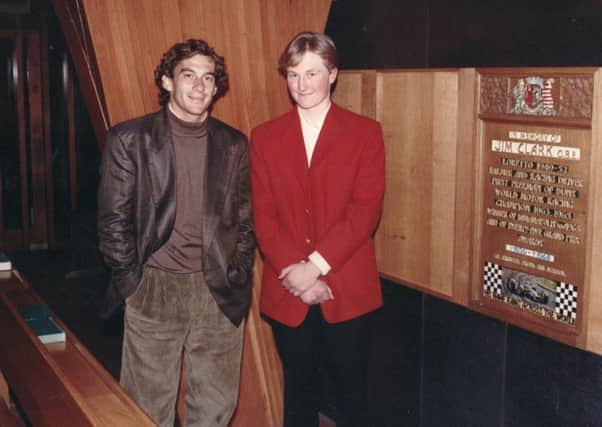When Ayrton Senna visted Musselburgh to pay tribute to Jim Clark


Despite being required to walk past a plaque in the school chapel paying tribute to Clark at least twice a week, pupils at the boarding school in Musselburgh might not have shared Senna’s faith. Even 27 years ago, Clark’s death at Hockenheim in 1968 was still nearly quarter of a century earlier.
He was a legend, no doubt. “His name rang across the world,” asserted the plaque at the school Clark attended between 1949 and 1952. But pupils were understandably more alert to Senna’s greatness.
Advertisement
Hide AdAdvertisement
Hide AdIt felt surreal to see him standing there on a stage at the school theatre in an outfit that reflected the times –turtleneck sweater, outsized shiny blazer and baggy corduroy trousers.
Red jackets with dark slacks was the required uniform for the couple of hundred children sitting mesmerised in front of Senna. What was a living, breathing Brazilian racing driver doing here, in Musselburgh, of all places?
Of course, just over three years later, Senna followed in Clark’s tread in a more profound and tragic way. His death following a crash at Imola in 1994 sent shockwaves around the world in the way Clark’s had done. It lends further poignancy to recently unearthed footage of Senna’s visit to Loretto.
Brazilian film makers documented his trip. In one clip, which surfaced on Facebook in 2016, 17-year-old pupil Malcolm Borthwick, later to become a BBC journalist, rises to his feet to pose Senna a question. It was perhaps trickier than the racing driver had expected. “Sir, how do you personally relate religion to Formula 1?”
“Hmmm,” replied Senna.
“I had a very nice experience today when I arrived in the school because I was taken to the chapel, which you all know… to talk about religion is a touchy point, is very difficult and very easy to be misunderstood. But to me it is a fact. It is not only by reading the bible, where you read black and white, but I try hard as I can to understand life through God. That means every day in my life. Not only when I am home, but when I am doing my work too...”
The footage cuts out here. And a flame was extinguished soon afterwards. But not before Senna lifted a further world champion title to bring his total to three, one above his hero Clark. “He was the best of the best,” Senna once said about Clark. “He was my boyhood hero.” Senna, shortly before his death, commissioned a painting showing a grid with the greatest drivers in history on it. He instructed the artist to place Clark in pole position.
So when Matt Amato, a pupil at Loretto, wrote to Senna inviting him to give a lecture, underlining the school’s part in Clark’s development, he knew there was a greater than normal chance he might accept.
“That was a big thing for him,” says Amato, now based in Atlanta in the United States. “Senna was pretty good at paying tribute to former drivers, like Clark and [Juan Manuel] Fangio. He had a grander view of these people. He thought of his place in history. He was reverent towards these names.”
Advertisement
Hide AdAdvertisement
Hide AdThere was extra leverage. Professor Sid Watkins, Amato’s Scottish stepfather who died six years ago, was the highly respected neurosurgeon credited with making F1 far safer than it once was. Watkins was among the first to reach Senna as he lay stricken at Imola. He was there as his great friend drew his last breath. Senna stayed at the family’s Coldstream home on the eve of his Loretto visit.
The Brazilian also made a private visit to the Jim Clark Room in Duns and signed the visitors’ book using his Sao Paulo home address. Then he travelled to Loretto, where he was met by Daniel Davidson, the eminently qualified pupil instructed to show Senna the chapel. Not only was Davidson an obsessive F1 fan, he hailed from Duns and, also like Clark, was from farming stock.
“As we walked in, he was by himself, two or three paces ahead,” recalls Davidson, now 45 and based in York. “He got to the altar, looked up at the big triangular stained glass window, with the Jim Clark plaque behind him, and said: ‘Wow, this truly is a special place’.”